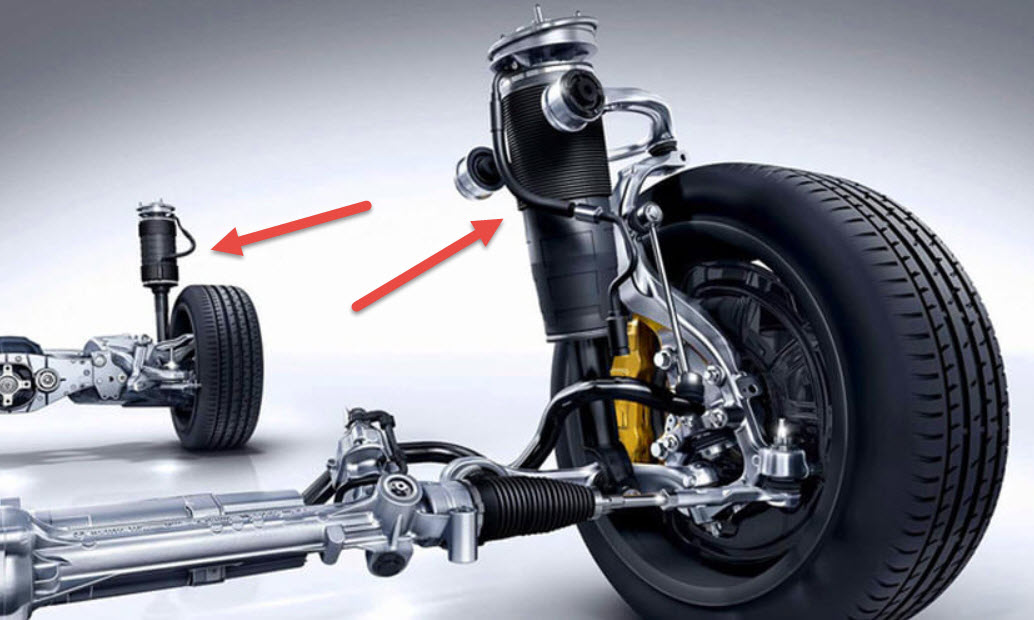
How does adjustable suspension work?
Every car's suspension—the set of parts that support it, cushion it from impacts, and allow it to turn—represents a design compromise. Automakers must consider many factors when designing the suspension of any vehicle, including:
- The weight
- Price
- Compactness
- Desired handling characteristics
- Desired ride comfort
- Expected Load (Passengers and Cargo) - Minimum and Maximum
- Clearance, both under the center of the car, and front and rear
- The speed and aggressiveness with which the vehicle will be driven
- Crash Resilience
- Service frequency and cost
With all of this in mind, it's surprising that automakers balance the various factors so well. The suspension of every modern car, truck and SUV is designed for different conditions and different expectations; no one is perfect in everything, and very few are perfect in anything. But for the most part, drivers get what they expect: a Ferrari owner expects great performance in high speed maneuvers at the expense of ride comfort, while a Rolls Royce owner usually expects and gets an eminently comfortable ride from a car that would a handful at the hippodrome.
These compromises are enough for many people, but some drivers - and some manufacturers - don't like to compromise if they don't have to. This is where adjustable suspensions come to the rescue. Some suspensions allow adjustment, either by the driver or automatically by the vehicle itself, to accommodate certain changes in conditions. Essentially, a car with adjustable suspension works like two or more different suspensions, depending on what is needed.
Some new cars are sold with adjustable suspension, while other adjustable setups are offered as "aftermarket" solutions, meaning the individual customer buys and installs them. But whether it's an OEM (original equipment manufacturer - automaker) or aftermarket, today's adjustable suspensions typically allow you to adjust one or more of the following.
Clearance
Some higher end vehicles can raise or lower the body depending on conditions, often automatically. For example, the Tesla Model S automatically raises when entering a roadway to avoid scratches and lowers at highway speeds to improve aerodynamics. And some SUVs can be set lower on flat roads for stability and economy, or higher off-road for increased ground clearance. This setting can be semi-automatic, as in the Ford Expedition (which rises when the driver engages four-wheel drive), or fully manual.
A variation on ride height adjustment is load-leveling suspension, in which the height is adjusted to accommodate heavy loads; usually the load is at the rear of the vehicle and the system responds by raising the rear until the vehicle is level again.
Ride height adjustment is usually done with airbags built into the springs; A change in air pressure changes the amount of lift. Other manufacturers use hydraulic systems to achieve the same goal, with pumps providing hydraulic pressure to help lift the vehicle.
An extreme ride height adjustment option is the aftermarket "airbag" system, which allows the car to be lowered and raised abruptly, sometimes even to the point where the car can bounce in the air. These systems are designed primarily for aesthetics, not ride or performance.
Ride Rigidity
Several cars (one of them is the Mercedes S-Class) are equipped with active suspension, which compensates for high-speed maneuvering by automatically stiffening the suspension; they perform this task using a pneumatic (air) or hydraulic (fluid) variable pressure reservoir. Ride stiffness adjustment is included in aftermarket systems that have adjustable spring rate and/or damper characteristics. Usually these adjustments require you to get under the car and manually change something, most commonly a dial on the shock that changes the shock's tendency to damp; cockpit-controlled systems, typically using airbags, are less common.
Note that the "sporty" suspension setting, i.e. firmer than normal, should not be confused with the "sporty" automatic transmission setting, which usually means shift points are set at slightly higher engine speeds than normal, improving acceleration with reduced fuel efficiency.
Other suspension geometry
Vehicles designed for special applications sometimes allow even more adjustment, often by turning bolts or other fittings to change the basic geometry of the system, such as by moving the rollbar attachment points. Similarly, trucks and trailers that must carry heavy loads sometimes offer springs with variable geometry—moving the spring attachment points—to accommodate those loads.
Dedicated racing cars go even further, allowing almost every aspect of the suspension to be adjusted. A qualified race mechanic can tailor a race car to each individual track. To a lesser extent, such systems can be used on road cars, although since adjustment usually requires tools and always requires stopping the car, it cannot be used to adapt to immediate changes such as higher speeds.
Height-adjustable suspension is becoming more common as a factory offering as fuel economy concerns grow. Most cars are more aerodynamic, which also means better fuel economy when they're lower. The other types of adjustable suspensions listed above are found mostly in aftermarket systems, especially adjustable shock absorbers and "coilovers" (systems consisting of a coil spring and an associated adjustable shock absorber or strut). But in either case, the goal is the same: to include an adjustment to accommodate different needs or conditions.